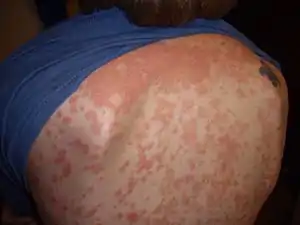Guttate psoriasis
Guttate psoriasis (also known as eruptive psoriasis) is a type of psoriasis that presents as small (0.5–1.5 cm in diameter) lesions over the upper trunk and proximal extremities; it is found frequently in young adults.[1]:410[2]:194
| Guttate psoriasis | |
|---|---|
 | |
| Back torso lesions, 30-year-old female patient | |
| Specialty | Dermatology |
The term "guttate" is used to describe the drop-like appearance of skin lesions. Guttate psoriasis is classically triggered by a bacterial infection, usually an upper respiratory tract infection.[3]:726
Signs and symptoms
Typically, guttate psoriasis erupts after a throat infection, or strep throat.[4] Initially, when the throat infection has cleared up, the person can feel fine for several weeks before noticing the appearance of red spots. They appear small at first, like a dry red spot which is slightly itchy. When scratched or picked, the top layer of dry skin is removed, leaving dry, red skin beneath with white, dry areas marking where flakes of dry skin stop and start. In the weeks that follow, the spots can grow to as much as an inch in diameter. Some of the larger ones may form a pale area in the center which is slightly yellow.
Guttate psoriasis can occur on any part of the body, particularly the legs, arms, torso, eyelids, back, bottom, bikini line, and neck. The number of lesions can range from 5 to over 100.[5] Generally the parts of the body most affected are seen on the arms, legs, back and torso.
Causes
Genetic and environmental factors can influence the predilection for guttate psoriasis. Human leukocyte antigens, especially those in the HLA-C group are associated with the skin disorder.[6] Beta-hemolytic streptococci infection is the major contributing environmental factor. The typical route of infection is the upper respiratory system. Rarely it is also caused by a skin infection surrounding the anus (perianal streptococcal dermatitis).[7][8]
Diagnosis
Guttate psoriasis can typically be diagnosed by clinical examination alone.[9]
Management
The treatments used for plaque psoriasis can also be used for guttate psoriasis. Few studies have specifically focused on guttate psoriasis management, so there are currently no firm guidelines for managing guttate psoriasis differently from plaque psoriasis.[10][11] Immunosuppressive drugs that inhibit T cell activation have been effective in treating severe cases of chronic guttate psoriasis.[12] Due to the role streptococcal infection plays in the development of guttate psoriasis, systemic antibiotics have been considered as a potential treatment option. There is uncertain evidence whether systemic antibiotics or tonsillectomy are effective and safe in treating the disease.[13] The condition often clears up on its own within weeks to months, and only about one third of patients will develop chronic plaques.[14]
Epidemiology
Guttate psoriasis accounts for approximately 2% of psoriasis cases.[5]
References
- Freedberg IM, Fitzpatrick TB (2003). Fitzpatrick's Dermatology in General Medicine (6th ed.). McGraw-Hill. ISBN 0-07-138076-0.
- James W, Berger T, Elston D (2005). Andrews' Diseases of the Skin: Clinical Dermatology (10th ed.). Saunders. ISBN 0-7216-2921-0.
- Pardasani AG, Feldman SR, Clark AR (February 2000). "Treatment of psoriasis: an algorithm-based approach for primary care physicians". American Family Physician. 61 (3): 725–33, 736. PMID 10695585. Retrieved 30 Mar 2011.
- Prinz JC (June 2001). "Psoriasis vulgaris--a sterile antibacterial skin reaction mediated by cross-reactive T cells? An immunological view of the pathophysiology of psoriasis". Clinical and Experimental Dermatology. 26 (4): 326–32. doi:10.1046/j.1365-2230.2001.00831.x. PMID 11422184.
- Langley RG, Krueger GG, Griffiths CE (March 2005). "Psoriasis: epidemiology, clinical features, and quality of life". Annals of the Rheumatic Diseases. 64 Suppl 2 (suppl 2): ii18-23, discussion ii24-5. doi:10.1136/ard.2004.033217. PMC 1766861. PMID 15708928.
- Mallon E, Bunce M, Savoie H, Rowe A, Newson R, Gotch F, Bunker CB (December 2000). "HLA-C and guttate psoriasis". The British Journal of Dermatology. 143 (6): 1177–82. doi:10.1046/j.1365-2133.2000.03885.x. PMID 11122018.
- Patrizi A, Costa AM, Fiorillo L, Neri I (June 1994). "Perianal streptococcal dermatitis associated with guttate psoriasis and/or balanoposthitis: a study of five cases". Pediatric Dermatology. 11 (2): 168–71. doi:10.1111/j.1525-1470.1994.tb00574.x. PMID 8041660.
- Herbst RA, Hoch O, Kapp A, Weiss J (May 2000). "Guttate psoriasis triggered by perianal streptococcal dermatitis in a four-year-old boy". Journal of the American Academy of Dermatology. 42 (5 Pt 2): 885–7. doi:10.1016/s0190-9622(00)90263-9. PMID 10767696.
- Mehlis S (2019). Duffin KC, Ofori AO (eds.). "Guttate psoriasis". Up-to-date. Wolters Kluwer.
- Chalmers RJ, O'Sullivan T, Owen CM, Griffiths CE (December 2001). "A systematic review of treatments for guttate psoriasis". The British Journal of Dermatology. 145 (6): 891–4. doi:10.1046/j.1365-2133.2001.04505.x. PMID 11899141.
- Chalmers RJ, O'Sullivan T, Owen CM, Griffiths CE (2000-01-01). "Interventions for guttate psoriasis". The Cochrane Database of Systematic Reviews (2): CD001213. doi:10.1002/14651858.CD001213. PMID 10796758. (Retracted, see doi:10.1002/14651858.cd001213.pub2. If this is an intentional citation to a retracted paper, please replace
{{Retracted}}with{{Retracted|intentional=yes}}.) - Vence, L; Schmitt, A; Meadows, CE; Gress, T. "Recognizing Guttate Psoriasis and Initiating Appropriate Treatment". West Virginia Medical Journal. 111 (2015): 26–29.
- Dupire G, Droitcourt C, Hughes C, Le Cleach L (March 2019). Cochrane Skin Group (ed.). "Antistreptococcal interventions for guttate and chronic plaque psoriasis". The Cochrane Database of Systematic Reviews. 3: CD011571. doi:10.1002/14651858.CD011571.pub2. PMC 6400423. PMID 30835819.
- Martin BA, Chalmers RJ, Telfer NR (June 1996). "How great is the risk of further psoriasis following a single episode of acute guttate psoriasis?". Archives of Dermatology. 132 (6): 717–8. doi:10.1001/archderm.1996.03890300147032. PMID 8651734.